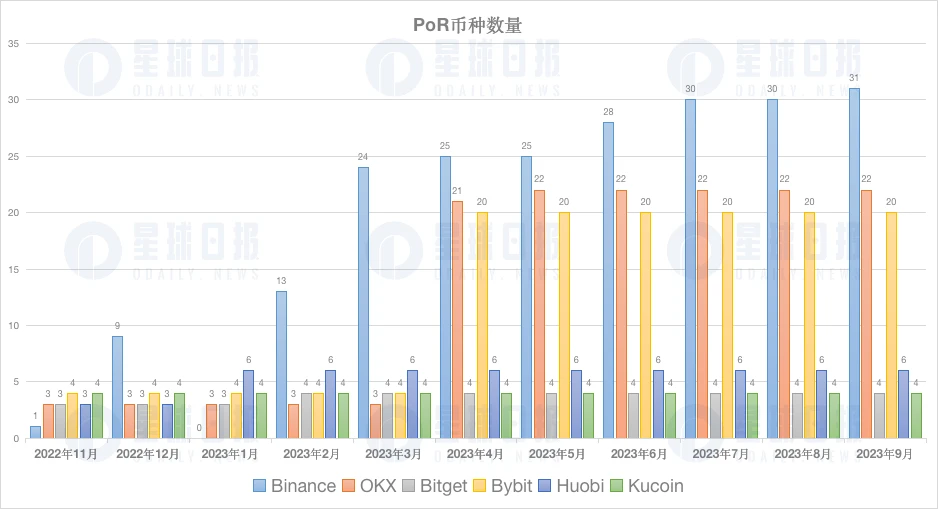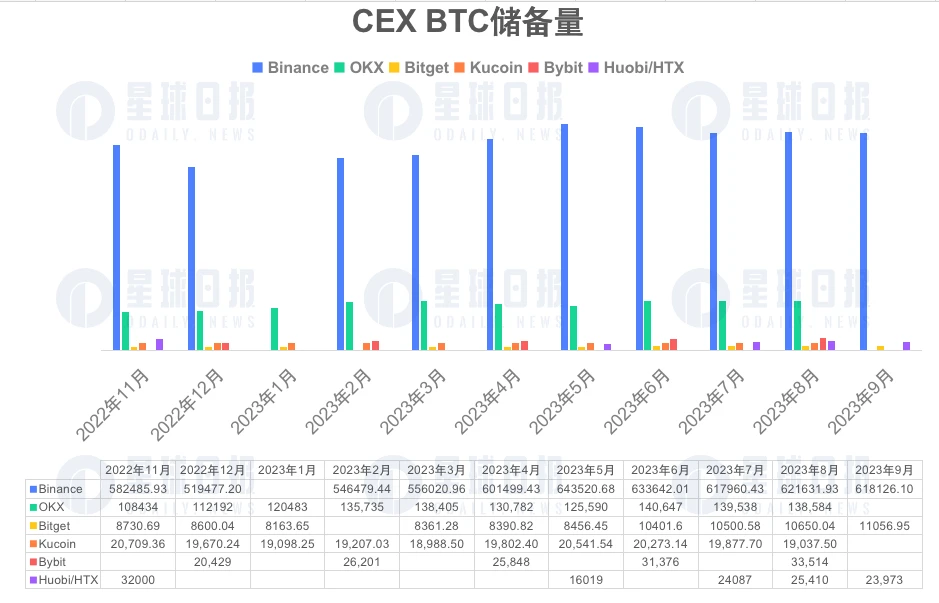CEX reserve proof investigation, which one has the highest risk?
*Written by: Qin Xiaofeng, * Odaily Planet Daily
Recently, the bankrupt FTX has had several new developments, coupled with Binance frequently facing doubts about a "liquidity crisis," further triggering market panic. With multiple factors overlapping, user attention to the proof of reserves (PoR) of CEX platforms has once again increased.
It has been 10 months since the collapse of FTX. Are the CEX platforms that once claimed to enhance industry transparency and regularly publish PoR reports truly fulfilling their promises?
Odaily Planet Daily conducted an investigation on several platforms including Binance, OKX, Bitget, Kucoin, Bybit, HTX (formerly Huobi), Gate, and Crypto.com, and found some interesting situations.
1. Binance and Other Platforms Regularly Publish PoR Reports
Binance, OKX, Bitget, and Kucoin have been releasing PoR reports on time every month since FTX's collapse in November last year, and they provide users with a Merkle Tree for open-source verification. Among them, Binance upgraded its system in January this year—using zk-SNARK technology to enhance its proof of reserves system, resulting in a missed report; Bitget also missed a report in February due to an overall platform upgrade.
Among the other platforms, Bybit publishes reports every two months, with a total of five PoR reports updated. HTX (Huobi renamed) claims to update data at the beginning of each month, but past PoR reports cannot be viewed on the official website; currently, only data from September 1 is visible—the data mentioned later is extracted from official press releases and may not be complete.

(Gate Report)
Currently, Gate only has "proof of reserves" issued by a third-party auditing agency, with publication dates in May 2020 and October 2022, and no further data has been presented since then, nor have they provided verification tools; Crypto.com only released an asset proof in December last year, and the promised Merkle Tree asset proof has yet to go live.
2. Binance's Total Reserves Far Ahead, Many CEX BTC Reserves Rising
From the statistics of each platform, Binance's total asset reserves are far ahead, ranking first every month, exceeding the combined reserves of several other platforms; OKX ranks second, consistently following Binance; Bybit surpassed HTX (Huobi renamed) in May this year to rank third. The changes in reserves for each platform are shown in the video below:
Overall, the asset reserves of each platform have shown significant growth compared to their initial announcements. An important reason is that the number of cryptocurrencies involved in the reserve announcements is increasing. Taking Binance as an example, the November 2022 report only disclosed BTC reserves, which increased to 9 types in the December report, and has continued to grow, with the latest September report showing a total of 31 tokens, the most among all CEX PoR reports.

OKX ranks second in the number of disclosed cryptocurrencies, increasing from the initial 3 types to 21 types in April this year—currently at 22 types; Bybit follows closely behind Binance and OKX, increasing from 4 types in the early days to the current 20 types. Bitget and Kucoin have remained steady at four types—BTC, ETH, plus two stablecoins (USDT, USDC).
Another consideration is the BTC reserve amount. Data from Odaily Planet Daily shows that Binance has the highest BTC reserve, currently around 618,000, followed by OKX (138,500). The BTC reserve situation for each platform is shown below:

The BTC reserves of Binance, OKX, Bitget, and Bybit have all shown significant growth compared to 10 months ago, with increases generally over 10%. Bybit has the highest increase (64%), followed by OKX (27.7%) and Bitget (26.6%); HTX (Huobi renamed) has seen the largest decline, with its BTC reserves once halved, currently recovering to 23,973.
The final indicator is the cleanliness of reserves, i.e., the proportion of non-platform token assets in total assets. The PoR reports from Bitget and Kucoin did not involve platform tokens, so they were excluded; among the other four, Bybit has the highest reserve cleanliness, exceeding 95% in the reports from April, June, and August; Binance follows closely, maintaining a reserve cleanliness above 85%, with a maximum of 87.69%; OKX and HTX (Huobi renamed) have reserve cleanliness between 50% and 60%, meaning nearly 40% of the reserves are platform tokens—HTX includes both HT and TRX in its platform token statistics.
3. Specific Reserve Analysis of Each Platform
Binance's total reserves have risen from $9.451 billion when first disclosed in November 2022 to a peak of $69.905 billion in May this year; however, due to the panic caused by the SEC lawsuit against Binance in June, there was a noticeable outflow of funds, with the final recorded amount for that month being $65.343 billion.
In the past two months, Binance's total asset reserves have continued to decline, but its BTC and ETH reserves have not shown a significant decrease compared to June. One possible explanation is that the overall downturn in the cryptocurrency market has led to a decrease in the value of total asset reserves.

OKX has seen several notable changes over the past 10 months: first, the BTC reserve amount has been steadily increasing; second, the stablecoin reserve amount has also been growing, from an initial $3.06 billion to $5.43 billion, an increase of over 70%. However, the value of OKX's platform token reserves has consistently remained above $10 billion, accounting for over 40%.
Bitget has seen continuous growth in both BTC reserves and total asset reserves, showing a positive trend, likely benefiting from its upgraded strategy this year—seizing various new coins to gain higher market attention. Bybit, like Bitget, has also seen steady increases in both BTC reserves and total asset reserves.
Overall, Kucoin has not experienced significant changes. Additionally, according to Nansen data, the proportion of the platform token KCS in Kucoin's address is 12.7%, and its reserve asset cleanliness also exceeds 85%.
Odaily Planet Daily will continue to track the asset reserve situation of each CEX.









